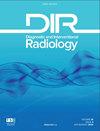内分泌相关疾病患儿Rathke裂隙囊肿的神经影像学特征
IF 2.1
4区 医学
Q2 Medicine
引用次数: 11
摘要
目的:探讨内分泌相关疾病患儿Rathke's cleft囊肿(RCCs)的发病频率和神经影像学特征,并探讨RCCs随访期间神经影像学特征的变化。我们假设rcc在患有内分泌相关疾病的儿童中更常见,并且由于磁共振成像(MRI)的高蛋白含量,大多数rcc既不显示液体强度也不显示强度。方法经当地伦理委员会批准,收集833例儿童(男/女338/495;平均年龄±SD, 9.4±3.7岁),于2016年1月至2019年1月期间进行回顾性研究。由儿科放射科医生评估rcc的大小、位置、信号强度和造影后增强模式。相同的影像学特征也由另一位放射科医生独立审查,通过使用kappa统计量(κ)和类内相关系数(ICC)来确定观察者之间的一致性。结果13.5%的患者MRI表现为明显的rcc(男孩/女孩39/74;平均年龄±SD, 9.8±3.9岁)。rcc的平均大小为5.5 mm(范围3.1-8.5 mm)。中枢性性早熟、尿崩症、催乳素高分泌患者的RCC发生率高于预期(P = 0.007)。rcc的平均大小在不同临床指征间无显著差异(P≥0.461)。所有rcc均在t2加权图像上显示异常信号,大多数(89%)由于蛋白质含量高,既没有液体强度也没有强度(即与正常垂体前叶相比,t1加权成像为等强度,t2加权成像为低强度)。84例rcc患者(74%)进行了MRI随访,平均随访时间为1.5年。在随访中,5例rcc消失;10例rcc平均体积增大,6例rcc平均体积减小。这些大小变化无统计学意义(P = 0.376)。随访期间未见rcc信号强度变化,仅4例rcc随时间蛋白质含量增加,影像学T1信号增加。rcc的MRI表现几乎完全一致(κ和ICC范围,0.81-1,P < 0.001)。结论在接受内分泌相关疾病检查的患者中,RCC并不罕见,近1 / 10的患者有RCC。rcc的大小和信号强度可能随时间而变化,其演变是不可预测的。大多数rcc在MRI上既没有显示液体强度,也没有显示强度,因为蛋白质含量高,所有rcc在t2加权成像上都有异常信号,因此无需在患者的随访成像中使用造影剂。本文章由计算机程序翻译,如有差异,请以英文原文为准。
The neuroimaging features of Rathke's cleft cysts in children with endocrine-related diseases.
PURPOSE
We aimed to evaluate the frequency and neuroimaging features of Rathke's cleft cysts (RCCs) in children examined for endocrine-related diseases and to determine changes in the neuroimaging features of RCCs during the follow-up of children. We hypothesize that RCCs are being more commonly diagnosed in children with endocrine-related diseases and most of the RCCs show neither fluid intensity nor intensity due to high protein content on magnetic resonance imaging (MRI).
METHODS
After approval by the local ethics committee, the medical records and contrast-enhanced pituitary MRI of 833 children (boys/girls, 338/495; mean age±SD, 9.4±3.7 years) were retrospectively reviewed between January 2016 and January 2019. The size, location, signal intensities, and postcontrast enhancement pattern of RCCs were assessed by a pediatric radiologist. Same imaging features were also independently reviewed by another radiologist to determine the interobserver agreement by using the kappa statistics (κ) and intraclass correlation coefficient (ICC).
RESULTS
RCC was evident on MRI in 13.5% of the patients (boys/girls, 39/74; mean age±SD, 9.8±3.9 years). The mean size of RCCs was 5.5 mm (range, 3.1-8.5 mm). An RCC frequency higher than expected was found in patients with central precocious puberty, diabetes insipidus, and hypersecretion of prolactin (P = 0.007). The mean size of RCCs did not show significant differences among the clinical indications for MRI (P ≥ 0.461). All RCCs showed abnormal signal on T2-weighted image and most (89%) showed neither fluid intensity nor intensity due to high protein content (i.e., isointense on T1-weighted imaging and hypointense on T2-weighted imaging compared with the normal anterior pituitary gland). Eighty-four patients with RCCs (74%) had follow-up MRI and the mean follow-up was 1.5 years. In follow-ups, five RCCs disappeared; the mean size of 10 RCCs increased and that of 6 RCCs decreased. These size changes were not statistically significant (P = 0.376). No signal intensity changes of RCCs were seen during the follow-up, except for 4 RCCs, whose protein content increased over time and T1 signals increased on imaging. Interobserver agreements were almost perfect for the MRI findings of RCCs (κ and ICC range, 0.81-1, P < 0.001).
CONCLUSION
RCCs were not uncommon in patients examined for endocrine-related diseases, and nearly 1 in 10 patients had an RCC. The size and signal intensities of RCCs may change over time and the evolution of RCCs is unpredictable. Most RCCs showed neither fluid intensity nor intensity due to high protein content on MRI, and all RCCs had an abnormal signal on T2-weighted imaging, thus eliminating the need to administer a contrast agent at follow-up imaging of the patients.
求助全文
通过发布文献求助,成功后即可免费获取论文全文。
去求助
来源期刊
CiteScore
3.50
自引率
4.80%
发文量
69
审稿时长
6-12 weeks
期刊介绍:
Diagnostic and Interventional Radiology (Diagn Interv Radiol) is the open access, online-only official publication of Turkish Society of Radiology. It is published bimonthly and the journal’s publication language is English.
The journal is a medium for original articles, reviews, pictorial essays, technical notes related to all fields of diagnostic and interventional radiology.

 求助内容:
求助内容: 应助结果提醒方式:
应助结果提醒方式:


